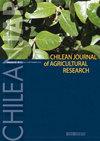Effects of biochar and fertilizer application on soil properties and nutrient status of lettuce
IF 1.7
4区 农林科学
Q2 Agricultural and Biological Sciences
引用次数: 1
Abstract
Different ways of benefiting from plant wastes in agricultural production are developed. One of the methods is to convert wastes into biochar and use it as a soil regulator. This study was conducted to determine the effects of biochar produced from tomato ( Solanum lycopersicum L.) plant waste on soil fertility and nutritional status of the lettuce ( Lactuca sativa L.) plant. For this purpose, the combined effect of five different doses of biochar (0, 10, 20, 30, and 40 t ha -1 ) and three chemical fertilizers (control, half-dose NPK and full-dose NPK) were investigated. The research was conducted in two cultivation periods. Biochar was applied to the soil just in the first period. In the first period, applications increased electrical conductivity, organic matter content, total N, and concentration of available P, Zn, and Mn, and the exchangeable K and Mg in the soil. Biochar and chemical fertilizer applications positively affected the lettuce plant’s N, P, and K concentrations. In the second period, concentrations of the available P, Fe, Zn, Mn, Cu and exchangeable Ca, Mg in soil, as well as the N, P, Ca, Mg, Zn, and Cu concentrations of the plant are higher compared to the first period. It was determined that biochar application alone was not sufficient for the nutrition of the lettuce plant, chemical fertilizers should be used additionally. In lettuce cultivation, half-dose NPK was recommended in addition to 30 t ha -1 biochar. As a result, it was determined that biochar produced from tomato plant waste was an effective soil improver material and might be an alternative source of K. kg ha -1 K 2 O). Application amounts were determined according to local recommendations. Ammonium nitrate, mono ammonium phosphate, and potassium nitrate were used as sources of fertilizer. The study was established as factorial and four replicates according to the design of the randomized plot. The first cultivation period was terminated on 20 December 2016, with the cutting of lettuce plants from the root collars. Since biochar is a material whose effects are long-lasting, its residual effects were intended to detect. Therefore, after the plants were cut from the root collars, four lettuce seedlings were planted in the same pots on 11 January 2017. As in the first trial, chemical fertilizers were applied in the same doses. The second cultivation period was completed with the cutting of lettuce plants from the root collars on 1 March 2017. At the end of the trial, wet and dry weights (dried at 65 °C for 3 d) of the plants cut from the root collars were determined.生物炭与肥料施用对生菜土壤性状和养分状况的影响
开发了多种利用农业生产中植物废弃物的方法。其中一种方法是将废物转化为生物炭,并将其用作土壤调节剂。本研究旨在研究利用番茄(Solanum lycopersicum L.)植株废弃物生产的生物炭对生菜(Lactuca sativa L.)植株土壤肥力和营养状况的影响。为此,研究了5种不同剂量生物炭(0、10、20、30和40 t / ha -1)和3种化肥(对照、半剂量和全剂量NPK)的联合效应。研究分两个栽培期进行。生物炭只在第一期施用于土壤。在第一个阶段,施用增加了土壤的电导率、有机质含量、全氮、速效磷、锌和锰的浓度以及交换性钾和镁。施用生物炭和化肥对生菜植株的氮、磷、钾浓度有正向影响。在第二阶段,土壤中有效磷、铁、锌、锰、铜和交换性钙、镁的浓度,以及植物体内氮、磷、钙、镁、锌和铜的浓度均高于第一阶段。结果表明,单独施用生物炭对莴苣植株的营养是不够的,应在施用化学肥料的基础上进行。在生菜栽培中,建议在30 t / 1生物炭的基础上添加半剂量氮磷钾。结果表明,从番茄植株废料中产生的生物炭是一种有效的土壤改良剂,可能是K kg ha -1 K 2o的替代来源。施用量根据当地建议确定。硝酸铵、磷酸一铵和硝酸钾作为肥料的来源。按随机图设计,采用因子分析法,设4个重复。第一个栽培期于2016年12月20日终止,生菜从根颈处被割下。由于生物炭是一种影响持久的材料,因此旨在检测其残余影响。因此,2017年1月11日,在将植株从根环上剪下后,在同一盆中种植了四棵生菜幼苗。与第一次试验一样,施用了相同剂量的化肥。第二个栽培期于2017年3月1日完成,从根环上切下生菜植株。试验结束时,测定从根颈上切下的植株的湿重和干重(65℃干燥3 d)。
本文章由计算机程序翻译,如有差异,请以英文原文为准。
求助全文
约1分钟内获得全文
求助全文
来源期刊
CiteScore
3.00
自引率
11.80%
发文量
60
审稿时长
6 months
期刊介绍:
ChileanJAR publishes original Research Articles, Scientific Notes and Reviews of agriculture, multidisciplinary and agronomy: plant production, plant protection, genetic resources and biotechnology, water management, soil sciences, environment, agricultural economics, and animal production (focused in ruminant feeding). The editorial process is a double-blind peer reviewing, Editorial Office checks format, composition, and completeness, which is a requirement to continue the editorial process. Editorial Committee and Reviewers evaluate relevance and scientific merit of manuscript.

 求助内容:
求助内容: 应助结果提醒方式:
应助结果提醒方式:


